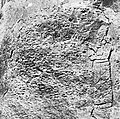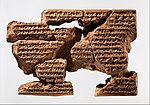Aššūr-bēl-kala, inscribed maš-šur-EN-ka-la (meaning "Aššur is lord of all"), was the king of Assyria in 1074/3–1056 BC, the 89th to appear on the Assyrian...
11 KB (1,327 words) - 18:46, 20 September 2024
BC, the 94th to appear on the Assyrian Kinglist. He was the son of Aššur-bēl-kala whom he briefly succeeded and was deposed by his uncle Šamši-Adad IV...
5 KB (609 words) - 18:48, 20 September 2024
king Aššur-bēl-kala and his immediate predecessor(s) as the Synchronistic King List places him alongside both Tukultī-apil-Ešarra and Aššur-bēl-kala. He...
9 KB (1,079 words) - 05:54, 10 June 2024
contemporary of the Assyrian King Aššur-bêl-kala and his reign was a golden age for scholarship. The broken obelisk of Aššur-bêl-kala relates that the Assyrians...
13 KB (1,699 words) - 05:53, 10 June 2024
"came up from Karduniaš (i.e. Babylonia). He ousted Eriba-Adad, son of Aššur-bêl-kala, seized the throne and ruled for 4 years". The king of Babylon was Adad-apla-iddina...
3 KB (394 words) - 18:50, 20 September 2024
Obelisk” which is usually attributed to Aššur-bel-kala, which describes his campaign during the eponym year of Aššur-rā’im-nišēšu, thought to be in his fourth...
3 KB (362 words) - 21:30, 9 June 2016
Marcus. "The Hunt is on again! Tiglath-pileser I's and Aššur-bel-kala's nāḫirū-Sculptures in Assur, in: H.D. Baker/K. Kaniuth/A. Otto (eds.), Stories of...
13 KB (1,513 words) - 18:37, 20 September 2024
the Synchronistic Kinglist he was a contemporary of the Assyrian king Aššur-bêl-kala where only the beginning of his name appears below that of his immediate...
5 KB (534 words) - 05:54, 10 June 2024
Ashur-uballit II (redirect from Aššur-uballiṭ II)
cuneiform script. Aššur-uballiṭ II, also spelled Assur-uballit II and Ashuruballit II (Neo-Assyrian Akkadian: 𒀸𒋩𒌑𒋾𒆷, romanized: Aššur-uballiṭ, meaning...
18 KB (2,515 words) - 13:25, 30 May 2024
later king lists and in an eponym list. He was succeeded by his brother Aššur-bel-kala, then his nephew Eriba-Adad II, then his other brother Šamši-Adad IV...
4 KB (442 words) - 18:38, 20 September 2024
List of Assyrian kings (section City-lords of Assur)
The king of Assyria (Akkadian: Iššiʾak Aššur, later šar māt Aššur) was the ruler of the ancient Mesopotamian kingdom of Assyria, which was founded in the...
87 KB (7,441 words) - 19:39, 20 July 2024
by Albert Kirk Grayson in 1991 reads: (Property of) the palace of Assur-bel-[kala, king of the universe, strong king, king of As]syria, son of Tiglath-pile-...
6 KB (618 words) - 11:07, 2 May 2024
Aššūr-bēl-nīšēšu, (Middle Assyrian Akkadian: 𒁹𒀭𒀸𒋩𒂗𒌦𒈨𒌍𒋙, romanized: ᵐᵈaš-šur-EN-UN.MEŠ-šú,) and meaning “(the god) Aššur (is) lord of his people...
5 KB (507 words) - 18:08, 20 September 2024
Ashur-nadin-apli (redirect from Assur-nadin-apli)
the placing of the eponyms, the Assyrian dating system, of Etel-pi-Aššur and Aššur-bel-ilani are correct. The latter part of his reign was characterized...
7 KB (834 words) - 18:22, 20 September 2024
cuneiform script. Aššur-etil-ilāni, also spelled Ashur-etel-ilani and Ashuretillilani (Neo-Assyrian Akkadian: 𒀸𒋩𒉪𒅅𒀭𒈨𒌍, romanized: Aššur-etil-ilāni, meaning...
11 KB (1,363 words) - 06:40, 30 May 2024
catastrophic period of decline after the death of Tiglath-Pileser's son Ashur-bel-kala (r. 1073–1056 BC), which saw the loss of most of the empire's territories...
98 KB (12,848 words) - 09:46, 12 August 2024
Assyria (Neo-Assyrian cuneiform: , māt Aššur) was a major ancient Mesopotamian civilization which existed as a city-state from the 21st century BC to...
140 KB (17,052 words) - 22:52, 28 September 2024
Esarhaddon (redirect from Aššur-taqīša-libluṭ)
Assarhaddon and Ashurhaddon (Neo-Assyrian Akkadian: 𒀭𒊹𒉽𒀸, also 𒀭𒊹𒉽𒋧𒈾 Aššur-aḫa-iddina, meaning "Ashur has given me a brother"; Biblical Hebrew: אֵסַר־חַדֹּן...
79 KB (9,735 words) - 16:55, 8 September 2024
king Aššur-bel-nišešu, an affiliation attested in brick inscriptions, king-lists and a tablet although a single king list gives his father as Aššur-rā’im-nišēšu...
6 KB (635 words) - 18:13, 20 September 2024
Ashur-nirari III (redirect from Assur-nirari III)
Aššur-nerari III, inscribed maš-šur-ERIM.GABA, “Aššur is my help,” was king of Assyria (1202–1197 BC or 1193–1187 BC). He was the grandson of Tukulti-Ninurta...
6 KB (693 words) - 23:46, 1 August 2024
Ashur-dan III (redirect from Assur-dan III)
Ashur-dan III (Neo-Assyrian cuneiform: Aššur-dān, meaning "Ashur is strong") was the king of the Neo-Assyrian Empire from 773 BC to his death in 755...
9 KB (1,074 words) - 07:35, 27 September 2023
early on in his reign. These early sons were likely Aššur-etil-ilāni and Sîn-šar-iškun. Aššur-etil-ilāni succeeded Ashurbanipal as king in 631 BC and...
42 KB (5,478 words) - 05:52, 10 June 2024
Ashur-dan I (redirect from Assur-dan I)
official during whose reign his predecessor died, Aššur-dān (the king), Atamar-den-Aššur, Aššur-bel-lite, and Adad-mušabši. A harem edict or palace decree...
5 KB (628 words) - 01:04, 28 June 2024
Early Assyrian period (section Origins of Assur)
The earliest inscription known from Assur, preceding that of Azazu, was made by the Išši'ak Aššur (governor of Assur) Ititi, son of an Assyrian man called...
35 KB (4,365 words) - 15:47, 10 July 2024
transcribed as Šarru-kīn I and Sharru-ken I) was the king (Išši’ak Aššur, "Steward of Assur") during the Old Assyrian period from c. 1920 BC to 1881 BC. On...
5 KB (574 words) - 08:50, 10 July 2023
Aššur-nērārī II, inscribed maš-šur-ERIM.GABA (=DÁḪ), "(the god) Aššur is my help," was the king of Assyria, the 68th to appear on the Assyrian Kinglist...
3 KB (294 words) - 18:08, 20 September 2024
Bel-bani or Bēl-bāni, inscribed mdEN-ba-ni, “the Lord is the creator,” was the king of Assyria from c. 1700 to 1691 BC and was the first ruler of what...
3 KB (340 words) - 08:25, 17 June 2022
Ashurnasirpal II (redirect from Aššur-nâṣir-apli)
Ashur-nasir-pal II (transliteration: Aššur-nāṣir-apli, meaning "Ashur is guardian of the heir") was the third king of the Neo-Assyrian Empire from 883...
24 KB (2,688 words) - 19:47, 12 September 2024
Ashurbanipal (redirect from Aššur-bāni-apli)
cuneiform script. Ashurbanipal (Neo-Assyrian Akkadian: 𒀸𒋩𒆕𒀀, romanized: Aššur-bāni-apli, meaning "Ashur is the creator of the heir") was the king of the...
101 KB (12,893 words) - 01:53, 24 September 2024
Sennacherib (redirect from Aššur-ilī-muballissu)
include Ile''e-bullutu-Aššur, Aššur-mukkaniš-ilija, Ana-Aššur-taklak, Aššur-bani-beli, Samaš-andullašu (or Samaš-salamšu) and Aššur-šakin-liti. The main...
97 KB (12,297 words) - 23:31, 24 September 2024













